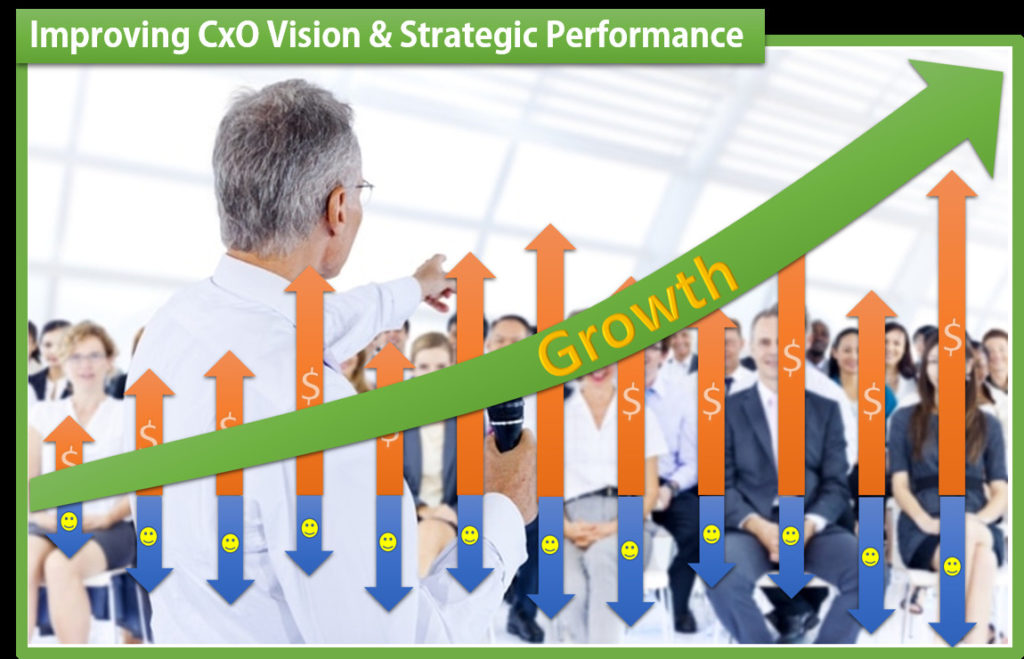
Corporate visions and strategies are a complex and often frustrating issue to discuss. Of 700 global CEOs that were surveyed over the last three years. (Source: https://iveybusinessjournal.com/publication/walking-the-talk-really-why-visions-fail/), most believed in a need for a vision and strategy. Equally, most believed they failed at getting the internal organization to make it happen. The CXO vision is constantly thwarted by the internal organizational limitations and obstacles to accomplish the same.
Conversely, if we look at the back end of the planning process, Forester Research has reported in a recent survey that 85% to 90% of sales calls add little or no value for the customer (Source: https://corporatevisions.com/value-proposition/). The customer is not necessarily aware of a good vision or strategy, but they are seeing nothing compelling coming from the sales and marketing effort.
The complexity of these two observations reflect a CEO vision, believed and desired, for the organization. At the bottom end, we find a customer that sees sales providing nothing of value. My hypothesis is that there are two major dysfunctions that are occurring at an alarming frequency.
· The CxO vision and strategic statements are not effectively operationalized.
· The organization’s failure to execute on vision and strategy is observable in the market.
In addressing the first issue, most vision statements are impotent. They are ending destinations (i.e. $40M in product sales). They are desires to achieve a specific success (i.e. win first sales of product). They are the organization stated cultural ideals (i.e. foster an open door policy). My contention is these vision and strategy statements, in total, are flawed in today’s competitive and global marketplace. They don’t specifically spell out a vision of “business acceleration.”
The most important vision that the CEO can impart to any organization is a specific idea of how the organization will accelerate sales over time, while declining effort for any given business, project, product or service. In my book, “Downhill, The Building of Fast Moving and Healthy Startups”, I discuss this and label it the Entrepreneurial Fulfillment Curve. If the vision or strategy is “not designed” to convey this, then it is both dated and destined for failure. If the only motivation for declining effort is cost reduction, then increased margin will not be achieved. Both aspects need to be addressed in vision.
I told a company recently that they had to effectively upgrade their product management and sales teams to have any hope of growth, and it was met as blasphemy. The reason I stated this was because product management and sales had both lacked a capacity to discover the Entrepreneurial Fulfillment Curve. Moreover, after working closely with these organizations, I determined that obstacles to high growth were more about the people, than the technology or market.
The HR leader strenuously objected and told me that the current people could be trained to do whatever the company needed. On the other hand, I knew that these people could not dimensionally perform in a high growth, scalable environment. Fast forward three years, and this organization has flat revenue and growing costs. No new initiative has been successful. It will ultimately become a commodity driven organization in decline.
In today’s world, vision and strategic statements must be designed with two positively affirmed characteristics.
1. High growth for new businesses (recognizing that legacy business may not every be high growth again).
2. Synergistic, scalable and increasing efficiency; as it relates to bringing business to market.
In accomplishing this you achieve increasing revenue relative to decreasing costs for improved margin. Without these statements in vision and strategy, my experience says an organization will never achieve high growth without CXO guidance from the top.
At Steve Day Design, I encourage you to purchase a copy of Downhill, available in paperback or ebook on Amazon Books and Kindle. I also encourage you to visit www.steveadaydesign.net and sign in. We will be doing a Podcast later this week to cover a case study on this subject. We will be happy to invite you in either case.
Steve A. Day
Steve Day Design
724-544-1490
Leave a Reply